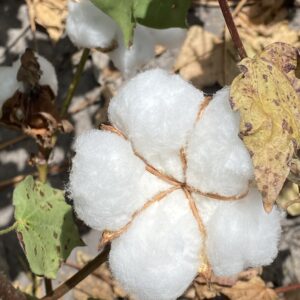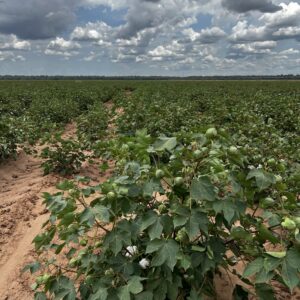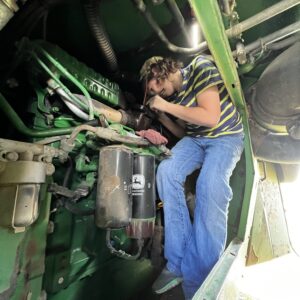28 Sep Sherry: Getting ready to roll
Hi y’all! My name is Sherry Zimmerman from Bishop, Texas. I am co-owner of Zimmerman Farms. I have been farming and custom harvesting with my husband Brian for over 20 years. He is a fourth-generation farmer and harvester. We have four kids: Wailynn and Wyatt, who are 14 years old and identical twins; Wesson is 12; and Whitleigh is 10. We are our harvest crew with the help of a few family members, too.

 We run combines and cotton pickers. We begin our combine harvest with wheat around mid-May in Texas and Oklahoma, and normally have that wrapped up in mid-July. We then head back to Texas to harvest our milo and corn crop. We always hope to have few days off after combine harvest to get our cotton pickers ready to roll, literally. However, this never happens. The kids and I run combines while Brian gets the cotton pickers ready.
We run combines and cotton pickers. We begin our combine harvest with wheat around mid-May in Texas and Oklahoma, and normally have that wrapped up in mid-July. We then head back to Texas to harvest our milo and corn crop. We always hope to have few days off after combine harvest to get our cotton pickers ready to roll, literally. However, this never happens. The kids and I run combines while Brian gets the cotton pickers ready.
We have not begun our cotton harvest yet but look forward to beginning in the next week or so. We run three John Deere 7760s and one CP690, all are cotton pickers-balers. Getting these pickers ready is not an easy task, so once the kids and I are finished combining, we join him in working on the pickers. We change about 7,200 spindles, 2,160 moisture pads, and 960 doffer pads—and these are the easier jobs. We are currently in the middle of replacing a turbo on one of our pickers. It has been challenging, from removing the turbo, to finding one in the United States, apparently there was only two, to trying to get the new one back in its place, we havetwisted off more bolts than expected and it has turned into a more difficult job than expected. However, we don’t quit, we push through the challenges because nothing compares to harvest time, especially cotton harvest. One of our favorite times of the year. Nothing else smells like picker grease and cotton.


Now, let’s talk little bit about cotton. Cotton in our area is planted early March and can be harvested as early as July or as late as October. However, this year in our area that is not the case, we suffered a severe drought and lost all of our cotton. Although this was the situation at home, we are thankful for our farmers further north of us that were able to produce a crop.
Cotton is a flowering plant. Its growing season is approximately 150 to 200 days. It is a beautiful plant to watch grow. Cotton is a fiber and is used for many, many things from money to baseballs, medical supplies to animal feed, rope to cooking oil and thousands of other items.We use baler cotton pickers to harvest cotton. They roll an 8-foot by 8-foot round bale of cotton, which is then covered with plastic wrap. The bale weighs about 5,000 pounds and consists of cotton, seed, and gin trash (minimal stalks, burrs and leaves). The bale will contain about 2,000 pounds of cotton and 3,000 pounds of gin trash. These bales are stacked in a row of four to eight, left at the edge of the field to be loaded in a module truck or on a semi-trailer, and hauled to the cotton gin. Sorry, y’all … the cotton gin is not an alcoholic beverage. Ha Ha! The cotton gin is where the cotton gets ginned. The cotton goes through the machine that separates the fibers from the seed and the gin trash. After this process you are left with a ginned cotton bale. Cotton is measured by lint pounds. Five hundred lint pounds makes up ginned bale of cotton. Hopefully next time we visit, we will be rolling up some cotton. We are excited to share this year’s cotton harvest with each of you. And look forward to answering any questions y’all may have about cotton harvest.
Sherry Zimmerman can be reached at sherry@allaboardharvest.com.
All Aboard Fall Harvest is brought to you by Unverferth Mfg. Co. Inc., ITC Great Plains, Pivot Bio, U.S. Custom Harvesters, T-L Irrigation, Titan Machinery, and High Plains Journal.

Sometimes you just need smaller hands. That’s where Wesson comes in.

Sorry, the comment form is closed at this time.